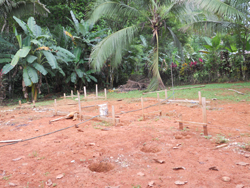Trendspotting: Learning by Doing
 Project Delivery through Volunteerism
Project Delivery through Volunteerism
Rio Claro, Costa Rica
With the scarcity of capital projects over the last several years, one might wonder why Correctional News elected to devote a recent print issue to project management. The answer, however, is relatively simple: get out in front of the curve. Based on all that has been offered in this issue, the curve is much like the road between San Jose and San Isidro — hairpins.
I am participating in a volunteer program to build a residence in a remote part of the Country, near the border with Panama. Last year the project was to complete a residence in an urban area near San Jose. Since my day job is too often defined by the abundance of creature comforts, this annual re-alignment helps clarify the definition of project delivery.
One aspect of delivering projects that has been addressed by several contributors to this issue is the transfer of risk. Essentially, this is the fundamental notion behind all projects: the assignment of responsibility to the party most qualified to manage the risk. The “project” can be making certain enough hardhats are available to structuring debt retirement, but the principle is the same; assign risk where the potential for the best outcome is the most likely.
 While the United States has a social infrastructure that is superior to most, we have not yet linked together all of the elements of project delivery for most government-sponsored initiatives. Design is still for the most part separated from construction and construction from financing, especially in jail and prison projects. Our colleagues in Canada and Mexico are ahead of us on bundling all three critical components of project delivery.
While the United States has a social infrastructure that is superior to most, we have not yet linked together all of the elements of project delivery for most government-sponsored initiatives. Design is still for the most part separated from construction and construction from financing, especially in jail and prison projects. Our colleagues in Canada and Mexico are ahead of us on bundling all three critical components of project delivery.
I accept that project delivery is far more than simply combining the design, construction, and financing into a single RFP. What I am learning most through my time spent on site, in the summer rainy season here in Costa Rica has to do with risk management, and I mean personal risk management. One critical lesson that is learned quickly in volunteer projects like these is how risk-adverse we become in traditional project delivery.
Like so many Central American countries, Costa Rica knows poverty, but perhaps not as bad as her neighbors to the north. The Pan American Highway, off of which our base camp and building site is located, is a lifeline of commerce that threads loosely connected towns and villages, some catering to affluent Americans seeking a bargain on a sea front condo and others to extended families accustomed to making do with what we would call a little.
There is no shortage of volunteers who make an annual trek to places like this for a variety of professional, political, and personal reasons.
Natural disasters seem to heighten our social conscience and we send old T-shirts, discarded sneakers, and even checks in order to feel better about ourselves. I’ve been there and done that, but was reminded a while back of something you may have told your children in the past; to whom much is given, much is required.
So, why not learn something while you give something? I took on this volunteer effort because of the unique opportunity to see project delivery, and particularly risk transfer, through the eyes of the user. Like many who read this magazine, I’ve been involved in various forms of delivering projects for many years. But what I learn from these hands-on experiences of literally working in the mud and hot sun with the one who will actually use the completed project is far different from the lessons of my day job.
Working with these marginalized people has sharpened my awareness not only of how projects are delivered through a principle that everything on the construction site is useable, but also how the method of delivery requires the entire village. Everyone commits to something and when risk (and reward) is transferred, the entire village is involved.
Many methods are available to satisfy a personal need to “pay it forward”. We all choose what works best for our individual goals, but for many of you that I know in the design, construction, and services professions, I highly recommend that you get your feet in the mud. Nothing like bunking in with eight other guys in a remote location without many normal amenities and reporting to a job site in pouring rain to set concrete columns to help you re-define risk transfer.
Since Correctional News has deadlines, I had to cut this short but hope the photographs illustrate that without any mechanized equipment or skilled labor, like-minded volunteers can make a difference in communities throughout all parts of our world. This has been written between rain breaks at the project site with lots of distractions, but I have to confess, my meager contribution pales in comparison to what I will take from this remote location about project delivery and risk transfer.
Stephen A. Carter, AICP, is principal of Carter Goble Lee LLC in Columbia, S.C.
